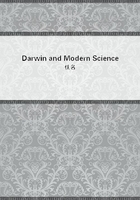
第228章
Is, then, the favourable result of crossing with a foreign stock to be attributed to the fact that this belongs to another systematic entity or to the fact that the plants, though belonging to the same entity were exposed to different conditions? This is a point on which further researches must be taken into account, especially since the analysis of the systematic entities has been much more thorough than formerly. (In the case of garden plants, as Darwin to a large extent claimed, it is not easy to say whether two individuals really belong to the same variety, as they are usually of hybrid origin. In some instances (Petunia, Iberis) the fresh stock employed by Darwin possessed flowers differing in colour from those of the plant crossed with it.) We know that most of Linneaus's species are compound species, frequently consisting of a very large number of smaller or elementary species formerly included under the comprehensive term varieties. Hybridisation has in most cases affected our garden and cultivated plants so that they do not represent pure species but a mixture of species.
But this consideration has no essential bearing on Darwin's point of view, according to which the nature of the sexual cells is influenced by external conditions. Even individuals growing close to one another are only apparently exposed to identical conditions. Their sexual cells may therefore be differently influenced and thus give favourable results on crossing, as "the benefits which so generally follow from a cross between two plants apparently depend on the two differing somewhat in constitution or character." As a matter of fact we are familiar with a large number of cases in which the condition of the reproductive organs is influenced by external conditions. Darwin has himself demonstrated this for self-sterile plants, that is plants in which self-fertilisation produces no result.
This self-sterility is affected by climatic conditions: thus in Brazil Eschscholzia californica is absolutely sterile to the pollen of its own flowers; the descendants of Brazilian plants in Darwin's cultures were partially self-fertile in one generation and in a second generation still more so. If one has any doubt in this case whether it is a question of the condition of the style and stigma, which possibly prevents the entrance of the pollen-tube or even its development, rather than that of the actual sexual cells, in other cases there is no doubt that an influence is exerted on the latter.
Janczewski (Janczewski, "Sur les antheres steriles des Groseilliers", "Bull. de l'acad. des sciences de Cracovie", June, 1908.) has recently shown that species of Ribes cultivated under unnatural conditions frequently produce a mixed (i.e. partly useless) or completely sterile pollen, precisely as happens with hybrids. There are, therefore, substantial reasons for the conclusion that conditions of life exert an influence on the sexual cells. "Thus the proposition that the benefit from cross-fertilisation depends on the plants which are crossed having been subjected during previous generations to somewhat different conditions, or to their having varied from some unknown cause as if they had been thus subjected, is securely fortified on all sides." ("Cross and Self fertilisation" (1st edition), page 444.)We thus obtain an insight into the significance of sexuality. If an occasional and slight alteration in the conditions under which plants and animals live is beneficial (Reasons for this are given by Darwin in "Variation under Domestication" (2nd edition), Vol. II. page 127.), crossing between organisms which have been exposed to different conditions becomes still more advantageous. The entire constitution is in this way influenced from the beginning, at a time when the whole organisation is in a highly plastic state. The total life-energy, so to speak, is increased, a gain which is not produced by asexual reproduction or by the union of sexual cells of plants which have lived under the same or only slightly different conditions. All the wonderful arrangements for cross-fertilisation now appear to be useful adaptations. Darwin was, however, far from giving undue prominence to this point of view, though this has been to some extent done by others. He particularly emphasised the following consideration:--"But we should always keep in mind that two somewhat opposed ends have to be gained; the first and more important one being the production of seeds by any means, and the second, cross-fertilisation." ("Cross and Self fertilisation" (1st edition), page 371.)Just as in some orchids and cleistogamic flowers self-pollination regularly occurs, so it may also occur in other cases. Darwin showed that Pisum sativum and Lathyrus odoratus belong to plants in which self-pollination is regularly effected, and that this accounts for the constancy of certain sorts of these plants, while a variety of form is produced by crossing.
Indeed among his culture plants were some which derived no benefit from crossing. Thus in the sixth self-fertilised generation of his Ipomoea cultures the "Hero" made its appearance, a form slightly exceeding its crossed companion in height; this was in the highest degree self-fertile and handed on its characteristics to both children and grandchildren.